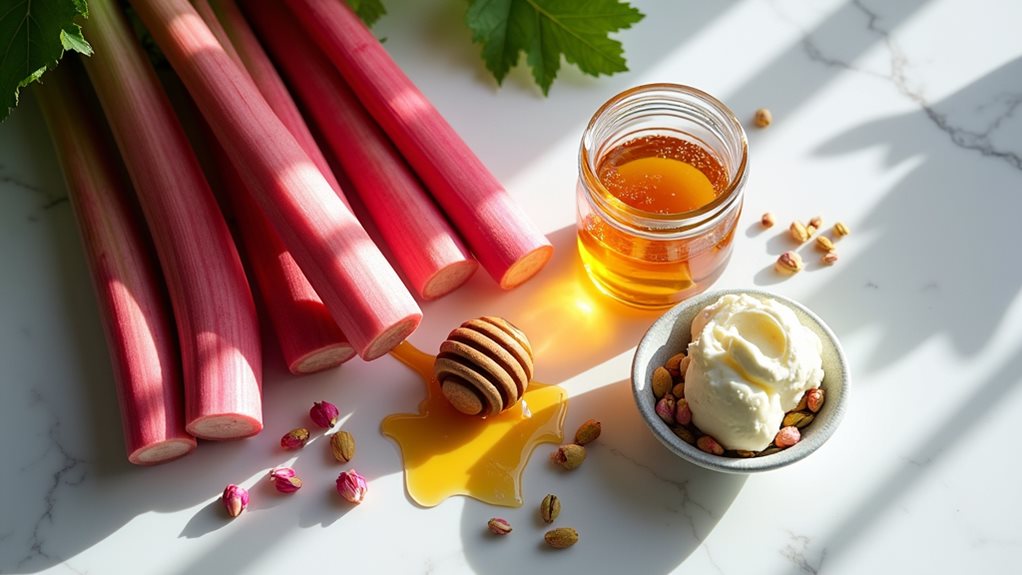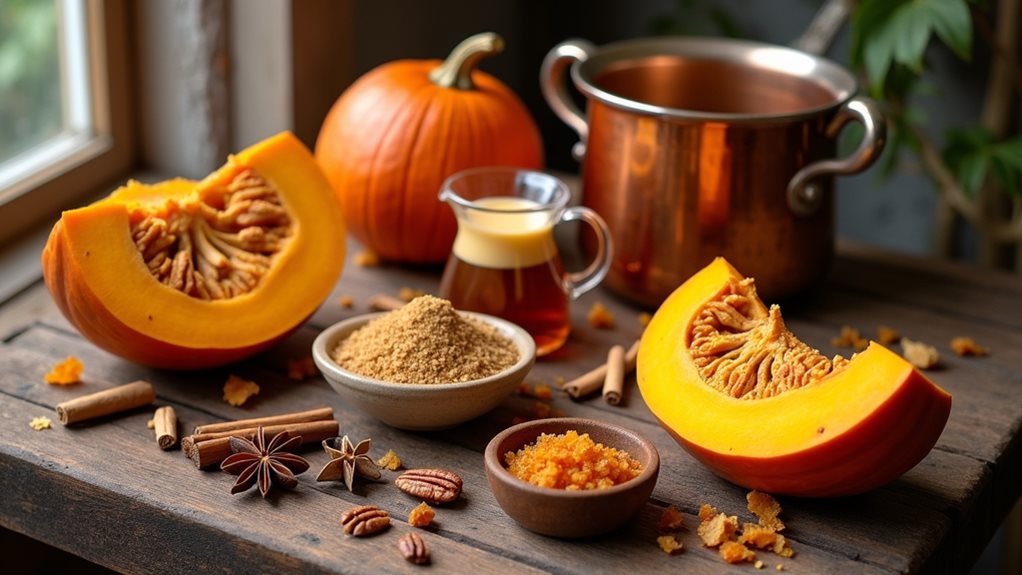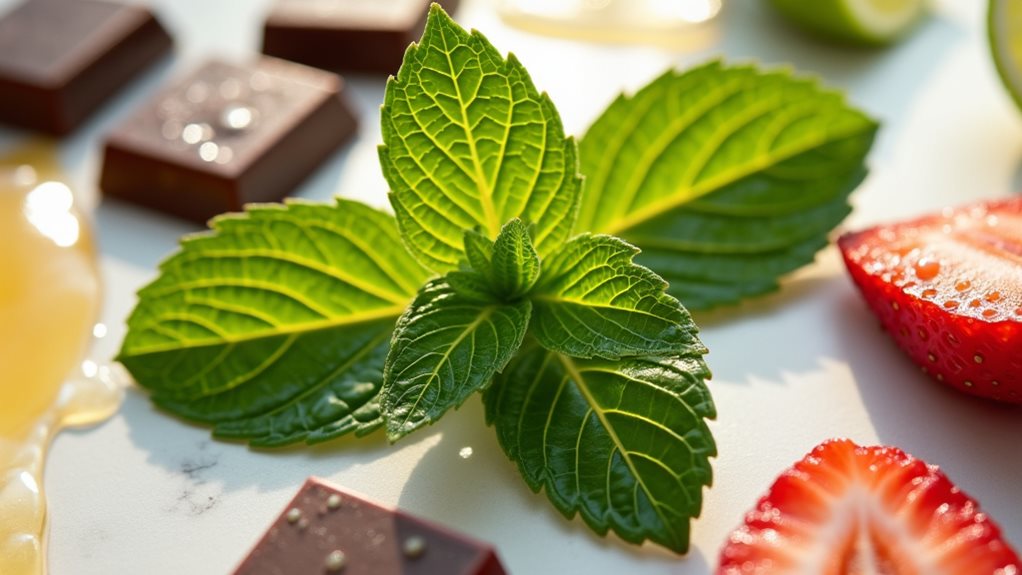Rhubarb's tartness pairs classically with strawberries for balanced sweetness, but don't stop there. You'll find it works beautifully with warm spices like cinnamon, cardamom, and ginger. Try herbs such as mint, thyme, or basil for complexity. In savory applications, rhubarb complements fatty meats like pork and duck through glazes or chutneys. It also shines with citrus fruits and spirits like gin and vodka in cocktails. The world of rhubarb pairings extends far beyond traditional combinations.
The Classic Strawberry-Rhubarb Duo: Why It Works
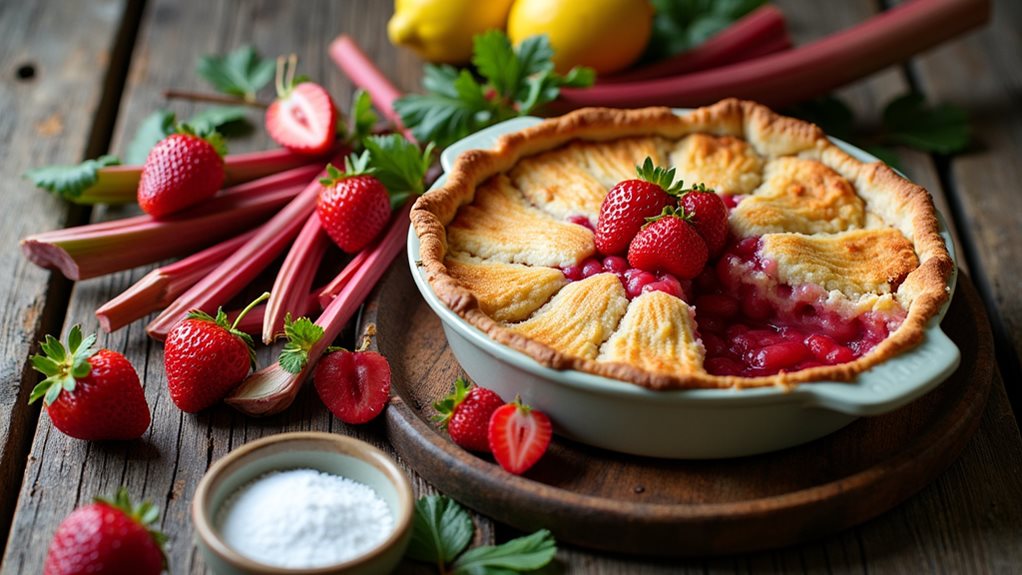
When you taste the irresistible combination of strawberries and rhubarb, you're experiencing one of nature's most harmonious flavor pairings. This culinary marriage balances the intense tartness of rhubarb—a vegetable with a fascinating rhubarb history dating back centuries—with the natural sweetness of strawberries.
The chemistry is perfect: rhubarb's oxalic acid meets the strawberry benefits of natural sugars and salicylic acid, creating a balanced flavor profile that's greater than the sum of its parts.
You'll find this duo works because it follows a fundamental culinary principle—contrasting flavors enhance each other.
When cooked together, the strawberries' sweetness tames rhubarb's sharpness, while the rhubarb adds complexity to the berries' profile. This unique flavor pairing transforms both ingredients into something truly special when prepared as a conserve. The combination delivers remarkable anti-inflammatory properties from both ingredients, making it as nutritious as it is delicious. This dynamic tension creates dishes that dance on your palate with sophisticated interplay.
Savory Rhubarb Applications in Main Dishes
While we often think of rhubarb in pies and desserts, you'll find it's equally remarkable in savory applications, particularly as a tangy glaze for meats like pork tenderloin or chicken thighs.
You Can transform this vibrant vegetable into sophisticated meat glazes that balance sweetness with acidity, creating caramelized exteriors that complement rich proteins beautifully. The combination of rhubarb with homemade BBQ sauce creates a uniquely flavorful experience for grilled meats. Consider fermenting rhubarb to develop a complex lactic acid profile that adds depth to your savory dishes.
Savory rhubarb chutneys, simmered with onions, ginger, and vinegar, offer another approach, providing a complex condiment that cuts through fatty meats and elevates everyday dishes to restaurant-quality status. Its tart profile brings brightness to rich dishes, making it an excellent addition to your culinary arsenal beyond traditional sweet applications.
Rhubarb-Infused Meat Glazes
Although traditionally featured in desserts, rhubarb's distinctive tartness creates an exceptional foundation for savory meat glazes that will transform your ordinary protein into a conversation-worthy entrée.
The key to mastering rhubarb glaze techniques lies in balancing its natural acidity with sweeteners like honey or brown sugar, while incorporating aromatic elements such as ginger and garlic.
For ideal meat glazing methods, begin by sautéing onions and ginger, then add chopped rhubarb and simmer until tender.
Blend for smoothness, then reduce to thicken. You'll find this versatile glaze works wonderfully with fatty cuts like pork and duck, but don't overlook its potential with chicken and salmon. Similar to the traditional mead glaze that creates a caramelized exterior on ham when roasted at high heat, rhubarb glazes develop beautiful color and texture when applied in multiple layers. The Rhubarb Ginger Sauce offers a sweet and spicy profile that perfectly complements both chicken and pork dishes.
Store your creation in the refrigerator for up to a week, or freeze for later culinary adventures that cross cultural boundaries.
Savory Rhubarb Chutneys
Beyond meat glazes, rhubarb finds a perfect home in savory chutneys that will revolutionize your main dish presentations. These versatile condiments balance rhubarb's natural tartness with brown sugar or jaggery, while apple cider vinegar amplifies the tanginess.
You'll discover spicy variations incorporating green chilies that complement grilled meats perfectly, while fruity combinations with dried cranberries and apricots add delightful texture when served alongside cheese boards.
For your next barbecue or picnic, try pairing a wine-based rhubarb chutney with pork, or enhance your sandwiches with a citrus-influenced version. The complex flavor profiles—ranging from tart to earthy with warm notes of cinnamon and nutmeg—create depth that elevates ordinary dishes.
Experiment with adding spicy kick of ginger for a flavor dimension that wonderfully complements the tartness of rhubarb or herbs like rosemary for aromatic dimension to create your signature chutney. When properly stored, these flavorful chutneys can last up to 3 years at room temperature due to their vinegar content.
Herbs and Spices That Elevate Rhubarb's Tartness
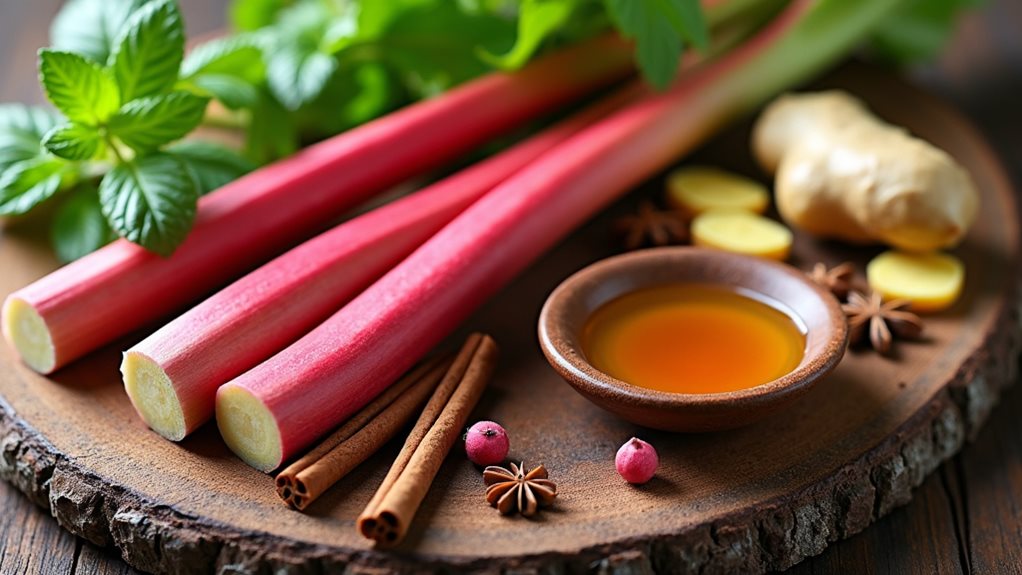
Warming spices like cinnamon, clove, and ginger naturally counterbalance rhubarb's sharp acidity, creating depth in both sweet and savory applications.
You'll find fresh herbs such as thyme, mint, and basil add unexpected complexity to rhubarb dishes, transforming simple preparations into sophisticated culinary experiences.
Sweet spices including Chinese five-spice, anise, and cardamom can elevate your rhubarb creations from ordinary to extraordinary, especially when you're looking to create unique flavor profiles in desserts or cocktails. The tanginess of rhubarb is beautifully complemented by citrus fruits like lemon, lime, and orange, adding brightness to seasonal spring cocktails. The Ultimate Fruit Flavor Pairing Chart serves as an excellent resource for inspiration when experimenting with unexpected rhubarb combinations in your kitchen.
Warming Spices Balance Tartness
The tartness of rhubarb, while beloved by many, can sometimes overwhelm the palate if left unbalanced in dishes. That's where warming spice combinations come into play. Traditional options like cinnamon, ginger, and nutmeg create depth that complements rhubarb's natural acidity without masking its distinctive character.
You'll find these tartness balancing techniques used across cultures—from Scandinavian desserts featuring cardamom to British preserves with ginger. When experimenting, try whole spices like cinnamon sticks for gentle infusion or ground versions for more immediate impact.
For complex flavor profiles, combine multiple warming spices like cloves, cardamom, and cinnamon. The key is moderation—these spices should enhance rhubarb's natural qualities rather than overwhelm them.
Whether in stews, pies, or modern cocktails, the right warming spices transform rhubarb's sharp edge into a balanced culinary experience. Similar to preparing butternut squash soup, it's important to start with small amounts of spices and adjust gradually to achieve the perfect balance of flavors.
Fresh Herbs Add Complexity
While warming spices create a foundation for balancing rhubarb's tartness, fresh herbs introduce an entirely new dimension of complexity to both sweet and savory rhubarb dishes.
You'll discover that unexpected herb combinations dramatically transform rhubarb's flavor profiles when paired thoughtfully.
Try these innovative herb pairings with your next rhubarb creation:
- Mint and basil brighten rhubarb cocktails, especially when mixed with gin or prosecco for invigorating summer drinks.
- Rosemary and thyme add savory depth to rhubarb crumbles, creating sophisticated desserts that aren't overwhelmingly sweet.
- Tarragon and chervil introduce subtle anise notes that complement rhubarb's acidity in both sweet compotes and savory applications.
Don't overlook fresh herbs when working with rhubarb—they're your secret weapon for elevating ordinary recipes into extraordinary culinary experiences.
Sweet Spices Transform Dishes
Sweet spices serve as transformative agents for rhubarb's naturally tart profile, creating balanced and complex flavor experiences that delight the palate.
Cinnamon's warm, woody notes counter rhubarb's acidity, while cardamom introduces citrusy undertones that elevate dessert flavor enhancement. You'll find that nutmeg and allspice add subtle warmth, particularly effective in pies and crumbles.
For innovative sweet spice combinations, try pairing ginger with brown sugar to create depth while tempering tartness.
Chinese Five-Spice, with its anise and cinnamon components, offers a multicultural dimension to traditional recipes.
When experimenting with these pairings, consider your cooking technique—roasting caramelizes rhubarb's sugars, intensifying sweetness, while stewing allows spices to fully infuse.
The transformation happens when these warming spices meet rhubarb's bright acidity.
Crafting the Perfect Rhubarb Cocktail
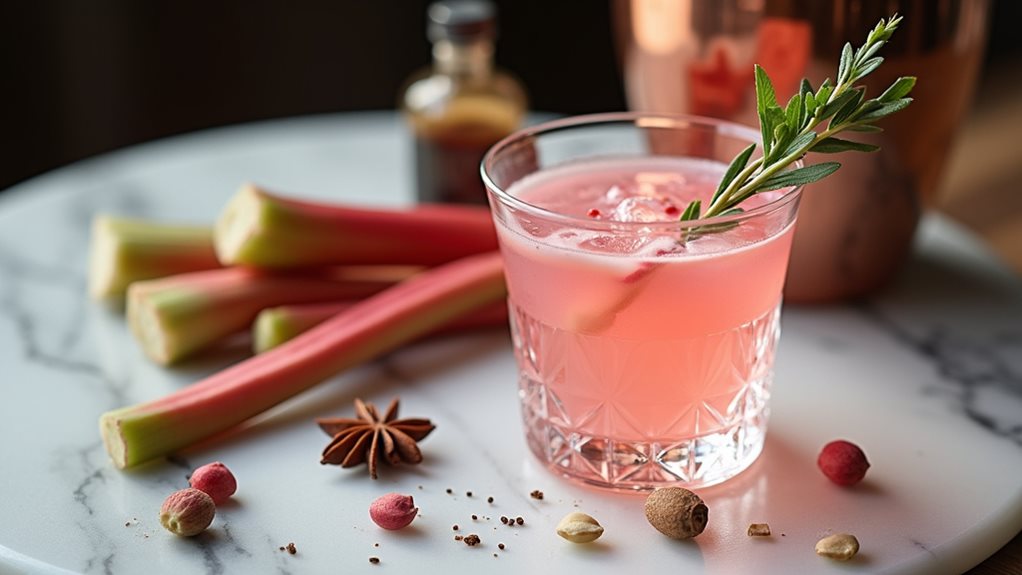
Creating perfect rhubarb cocktails requires understanding how this vibrant spring vegetable's tart profile can harmonize with complementary ingredients. The key to memorable rhubarb cocktails lies in thoughtful flavor combinations that balance its natural acidity while highlighting its unique character.
For extraordinary results, consider these essential elements:
- Base spirits matter – Gin's botanicals naturally complement rhubarb's tartness, while vodka offers a neutral canvas that lets rhubarb shine.
- Herbal infusions add complexity – Incorporate rosemary, thyme, or basil to introduce aromatic dimensions without overpowering the star ingredient.
- Homemade rhubarb syrup transforms ordinary drinks – Combine cooked rhubarb with sugar and citrus peels, then strain carefully for a crystal-clear, flavor-packed addition that elevates any cocktail.
You'll find warm spices like ginger and cardamom particularly effective when seeking depth in your creations.
Citrus and Rhubarb: A Match Made in Culinary Heaven
When exploring the world of rhubarb pairings, citrus fruits emerge as perhaps the most natural and harmonious companions.
You'll find that lemon tartness perfectly balances rhubarb's acidity in desserts, while orange marmalade creates a sweet-tart contrast that elevates both flavors. The distinctive grapefruit balance works wonderfully in savory applications, offering a bitter note that complements rhubarb juice in surprising ways.
For innovative seasonal recipes, try experimenting with lime infusion in rhubarb cocktails or adding citrus zest to rhubarb preserves for brightness.
The deep ruby color of blood orange paired with rhubarb creates visually stunning dishes with complex flavor profiles.
Whether in desserts, preserves, or even marinades, this pairing offers endless possibilities to enhance your culinary repertoire.
Unexpected Sweet Companions for Rhubarb
Beyond the zesty brightness of citrus, rhubarb finds unexpected harmony with companions from the sweeter side of the culinary spectrum.
When you're looking to elevate your rhubarb creations, consider these unique pairings that balance its natural tartness with complementary sweetness.
- Rice pudding with cardamom-infused rhubarb – The soft, creamy texture contrasts beautifully with rhubarb's tang, creating a dessert that's both comforting and surprising.
- Chocolate Guinness cake topped with poached rhubarb – The rich, bitter notes of the cake find perfect balance in rhubarb's bright acidity.
- Sweet cicely and rhubarb – This garden companion allows you to reduce added sugar in recipes while maintaining harmony of flavors, making it ideal for health-conscious desserts.
Rhubarb's Role in Global Cuisine
The humble rhubarb stalk has traveled an extraordinary journey through five millennia of human history, transforming from a purely medicinal root in ancient China to a versatile culinary ingredient celebrated across continents.
As you explore rhubarb history, you'll discover how this once-expensive medicinal plant (worth more than cinnamon and saffron in Europe) eventually found its way into kitchens worldwide.
Today, rhubarb variations appear in Finnish fruit wines, Russian stews, and British crumbles. You'll find it lending tangy brightness to duck in France and complementing pork dishes across Scandinavia.
Its cultural significance varies dramatically—from being a "pie plant" in America to a savory component in Middle Eastern cuisine.
When experimenting with global rhubarb recipes, remember that its adaptability makes it perfect for fusion cooking, bridging culinary traditions across borders.
Frequently Asked Questions
Can You Eat Rhubarb Leaves?
No, you shouldn't eat rhubarb leaves. They're highly toxic due to oxalic acid. Stick to cooking rhubarb stalks only. Understanding rhubarb toxicity is essential for safe consumption—the leaves can cause severe illness or death.
How Do You Store Fresh Rhubarb?
Rhubarb wilts faster than a snowman in July! Store fresh stalks wrapped loosely in the refrigerator's crisper drawer. For long-term preservation, try freezing rhubarb in airtight container storage after cutting into one-inch pieces.
What's the Best Way to Reduce Rhubarb's Tartness?
Balance rhubarb's tartness with sugar or sweeteners while roasting or poaching it. You'll get best results using non-aluminum pans over low heat. Try adding vanilla, cream, or sweet cicely for an innovative flavor balance.
Are There Different Varieties of Rhubarb to Choose From?
There's a mountain of rhubarb types available for your culinary uses! You'll find varieties from brilliantly red Canada Red to sweeter German Wine. Each offers different colors and tartness levels for your innovative kitchen experiments.
When Is Rhubarb in Season?
Rhubarb's in season from late April through mid-June. You'll find it actively growing for 8-10 weeks in spring. It's the perfect time to experiment with seasonal recipes while stalks are fresh and flavorful.
Final Thoughts
You've now explored the universe of rhubarb pairings that can transform this humble stalk from a simple garden vegetable into the crown jewel of your culinary repertoire. Whether you're combining it with strawberries in a classic pie, infusing cocktails, or experimenting with savory applications, rhubarb's versatility knows no bounds. By understanding complementary flavors that balance rhubarb's natural tartness, you'll reveal countless opportunities to elevate your cooking with this distinctive spring treasure.

